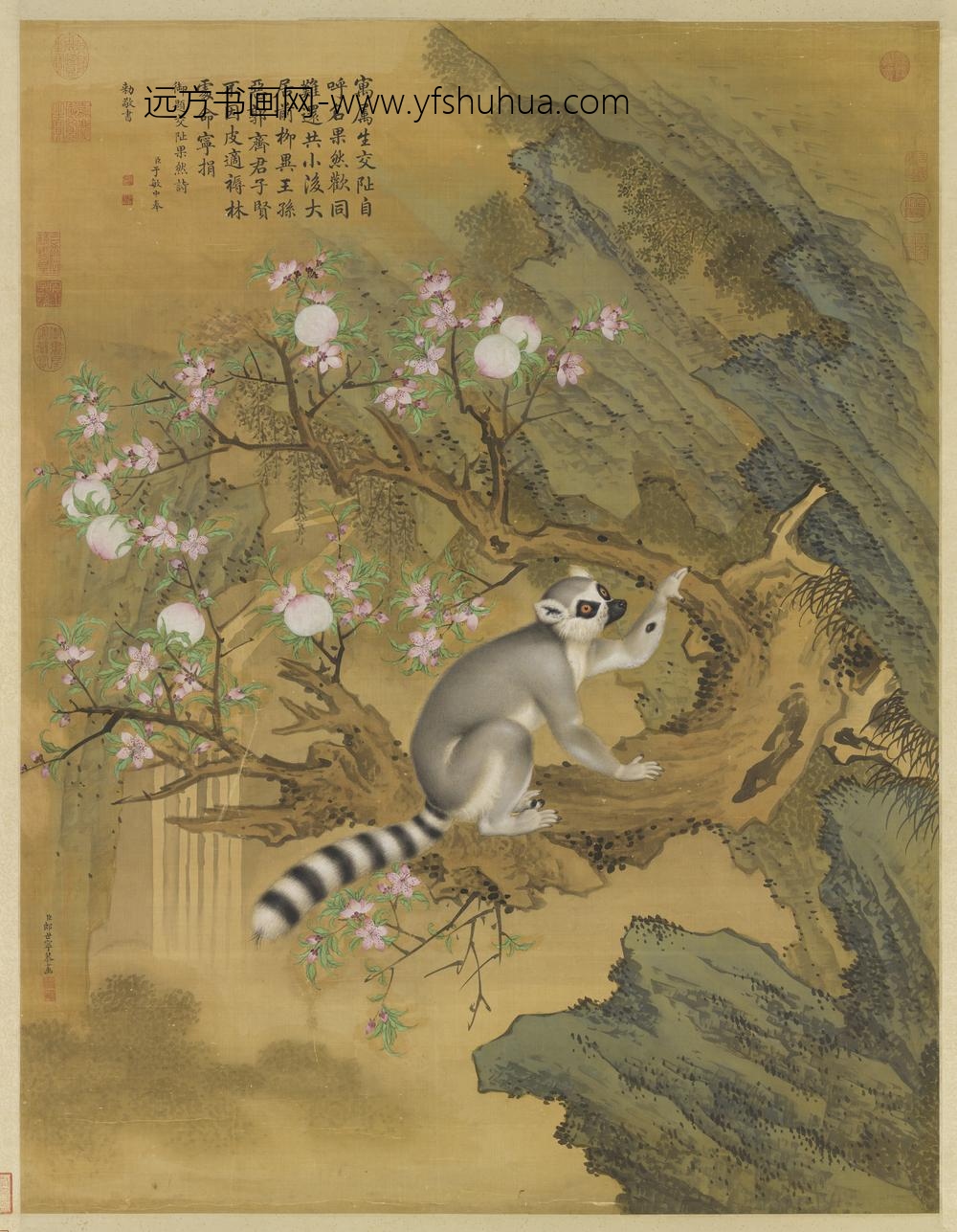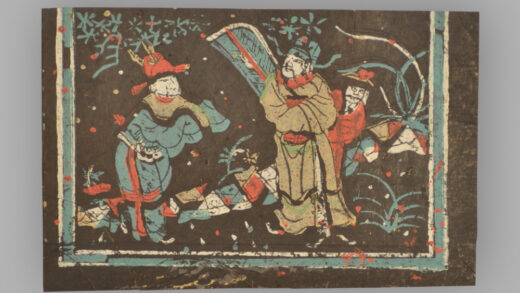【作品基本信息】
| 作者 | 郎世宁 |
| 品名 | 画交址果然图轴 |
| 朝代 | 清代 |
| 文件大小 | 18.04MB |
| 分辨率(DPI) | 300×300 |
| 像素大小 | 2161×2783 |
| 尺寸(CM) | 18.29×23.56 |
| 作品数量 | 1 |
| 作品收藏 | 台北故宫博物院 |
| 图片格式 | 默认提供TIF和JPG两个版本 |
基本数据
| 藏品类型 | 绘画 |
| 品名 |
清郎世宁画交址果然 轴 Lemur from Cochin |
| 分类 | 绘画 |
| 作者 | 郎世宁;Lang Shining;Giuseppe Castiglione |
| 数量 | 一轴 |
典藏尺寸
| 【位置】 | 【尺寸】(公分) |
| 本幅 | 109.8×84.7 |
质地
| 【质地位置】 | 【质地】 |
| 本幅 | 绢 |
题跋数据
| 【题跋类别】 | 【作者】 | 【位置】 | 【款识】 | 【书体】 | 【全文】 |
| 作者款识 | 郎世宁 | 本幅 | 臣郎世宁恭画 | 楷书 | |
|
印记: 臣郎世宁、恭画 |
|||||
| 题跋 | 于敏中 | 本幅 | 臣于敏中奉敕敬书 | 楷书 | 寓属生交趾。自呼名果然。欢同难还共。小后大居前。柳异王孙恶。郭齐君子贤。不因皮适褥。林处命宁捐。御题交址果然诗。臣于敏中奉敕敬书。 |
|
印记: 臣于敏中印、报国文章 |
|||||
印记资料
| 【印记类别】 | 【印记】 |
| 鉴藏宝玺 | 乾隆御览之宝 |
| 鉴藏宝玺 | 嘉庆御览之宝 |
| 鉴藏宝玺 | 乾隆鉴赏 |
| 鉴藏宝玺 | 石渠宝笈 |
| 鉴藏宝玺 | 三希堂精鉴玺 |
| 鉴藏宝玺 | 宜子孙 |
| 鉴藏宝玺 | 石渠定鉴 |
| 鉴藏宝玺 | 宝笈重编 |
| 鉴藏宝玺 | 御书房鉴藏宝 |
主题
| 【主题类别】 | 【主题(第一层)】 | 【主题(第二层)】 | 【主题说明】 |
| 其他主题 | 山水 | 瀑布 | |
| 主要主题 | 花草 | 桃花 | |
| 其他主题 | 果蔬 | 桃子 | |
| 主要主题 | 走兽 | 猴 | 交址果然 |
| 其他主题 | 树木 |
技法
| 【技法】 | 【技法细目】 |
| 皴法 | 斧劈皴 |
| 苔点 |
参考数据
| 【类别】 | 【参考数据】 |
| 收藏着录 | 石渠宝笈续编(御书房),第四册,页2257 |
| 收藏着录 | 故宫书画录(卷五),第三册,页574 |
| 收藏着录 | 故宫书画图录,第十四册,页43-44 |
| 参考书目 |
1.韩北新,〈郎世宁绘画系年(五)〉,《故宫文物月刊》,第71期(1989年2月),页68-69。 2.林莉娜,〈画里的环尾狐猴 — 郎世宁〈画交址果然〉考辨〉,《故宫文物月刊》,第268期(2005年7月),页10-23。 |
| 内容简介(中文) | 郎世宁(公元一六八八-一七六六年),意大利人。十九岁时,入天主教耶稣会为修士。曾习油画,兼习建筑。二十七岁来华传教,以绘事供奉内廷。历仕康熙、雍正、乾隆三朝。画法参酌中西,善画人物、花鸟,尤擅犬马。 画桃树一株,自山崖边斜伸而出,花叶盈枝,果实累累。果然攀枝欲上,似有所顾,神态疑惑,观物深至,传神绝妙。交址为清之藩属国安南,乾隆二十六年(一七六一)安南王新立,是年累有进珍禽异兽,乾隆曾写御制诗题咏此事,与画中诗同。时郎世宁七十三岁。 |
| 内容简介(英文) | Lang Shih-ning is the Chinese name used by the Italian, Giuseppe Castiglione. At the age of 19, Castiglione entered the Jesuit order in Italy as a novitiate, and his early training included painting and architecture. He was subsequently sent to China and arrived in 1715. His artistic skills came to the attention of the emperor, and he served in the inner court during the K’ang-hsi (1662-1722), Yung-cheng (1723-1735), and Ch’ien-lung (1736-1795) reigns as a painter. He combined his previous training with studies of Chinese painting techniques to create a style fusing the best of both traditions. He excelled at depicting figures, birds-and-flowers, and especially dogs and horses. In this painting, a peach tree extends diagonally from a cliff-like area, its branches laden with fruit and blossoms. A lemur, which appears similar to a raccoon, rests its hand on the branch. Its head is raised as though looking at something, and its facial expression is one of alertness. Cochin was part of the subject state of Annam belonging to the Ch’ing empire in what is present-day Vietnam. Over the years, the rulers of Annam had offered exotic animals as tribute to the Ch’ing court, and in 1761, this lemur was presented to the Ch’ien-lung emperor. The Ch’ien-lung emperor composed a poem on this animal, which also appears on this painting. Thus, Castiglione was 73 when he finished this painting. |
| 内容简介(中文) | 朗世宁(公元一六八八-一七六六年),意大利人,耶稣会教士,以绘画供奉内廷。历仕康熙、雍正、乾隆三朝。画法参酌中西。 成画于乾隆二十六年(公元一七六一年),这幅画绘制的可能是产于马达加斯加岛附近的环尾狐猴。但是画上乾隆却指称其为来自交趾(现在越南)的果然兽。原产于印度洋的环尾狐猴是否有可能经由越南的进贡来到清廷呢?有待考察。 |
| 内容简介(英文) | Lang Shih-ning was an Italian who at the age of 19 became a novitiate of the Jesuit Catholic order. At the age of 27, he arrived in China as a missionary. With his background in art, he also served the court as a painter under the K’ang-hsi, Yung-cheng, and Ch’ien-lung emperors. His style is marked by a fusion of Chinese and Western techniques. This work, done in 1761, depicts a ring-tailed lemur (lemur catta) native to Madagascar. However, the Ch’ien-lung Emperor’s inscription calls it a “kuo-jan” from Cochin (modern Vietnam), a Ch’ing tributary stae. Is it possible that a ring-tailed lemur originally from the western Indian Ocean was presented as tribute to the Ch’ing court via Vietnam? Perhaps further research will answer this question. |
| 参考书目 | 王湘文、何炎泉、陈建志,〈清郎世宁画交址果然 轴〉,收入《故宫动物园》(台北:国立故宫博物院,2019.07),页56。 |
| 参考书目 | 林莉娜,〈清郎世宁画交址果然 轴〉,收入何传馨主编《神笔丹青-郎世宁来华三百年特展》(台北:国立故宫博物院,2015.10),页216-219。 |
【作品展示】

清郎世宁画交址果然轴




